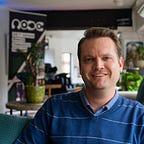A Decentralized Autonomous Nation (DAN)
As job automation continues to rise at exponential rates, we need to start thinking about the realities of what will happen when one-third of our existing workforce ends up on the outside looking in over the next decade. What will all of us do for employment? Will there be any infrastructure in place to catch us and allow us to continue working when our services are no longer needed by a company? Does it even make sense to continue building into this growth-fueled, economic model knowing that we are essentially driving the Titanic straight into an iceberg?
If we want to change course and avoid the iceberg, we need to change our focus. Recent focus has been around a Decentralized Autonomous Organization (DAO) or a Decentralized Autonomous Company (DAC), but the best use of today’s technology is a Decentralized Autonomous Nation (DAN), which operates at the individual level. Enabling individual participation requires removing the company or organization from the equation altogether, instead creating a user-centric entry point into the system for a personalized work experience. The “organization” should be formed in an ad-hoc manner to bring people together to solve problems, appearing as a shell company to provide the operating structure. Once the problem — the core reason for the formation of the “organization” that arose from an individual need— has been solved, that shell company will dissolve, and new shell companies will spin up to solve other individual needs in the ecosystem…formed by the personalized grouping of individuals most capable of servicing specific needs.
We can achieve this shift in economic structure by focusing on 3 layers of technology development: infrastructure, data, and application.
Establishing the base infrastructure for a Decentralized Autonomous Nation, which allows for a fundamental shift in the way that we use the internet for work, education, healthcare, and, ultimately, governance.
- Agreement on a global cryptocurrency that can remain independent of national currencies, power an ecosystem/economy on its own, and unlock the earning potential of nearly 2 billion people without bank accounts.
- Advancement of the blockchain so that official records can be stored, referenced, and verified in a transparent and agile way.
- Development of protocols that can verify identities, provide privacy, establish security, consolidate profiles, validate skills, provide organizational structure, and enable mechanical turk.
- Enablement of smart contracts that can be leveraged for agreements in a world of peer-to-peer work.
Setting up the foundational components of the data layer, which will feed user-centric applications and Artificial Intelligence. In order to reverse entropy (chaos), you need to establish an anchor in centropy (structure).
- Creation of individually owned and managed profiles that are used as the start of a user’s journey into the blockchain. These profiles should be part of a larger global database, where skills are captured at the sub-skill level and tasks are captured at the sub-task level. Think of this at an atom being broken down into subatomic particles.
- Enablement of personalization, leveraging Artificial Intelligence and principles of Customer Relationship Management to build new shell companies in a user-centric way on top of the foundation.
- Inclusion of data categorization in the largest knowledge repositories, which would allow knowledge articles to be pulled into the application layer (I’m looking at you, Everipedia).
Developing applications to sit on top of the decentralized network, giving people a means of self-management in this new world of independent workers.
- Opening up collaboration tools as a landing spot for the shell companies that are being created in an ad-hoc manner by Artificial Intelligence in the data layer.
- Building workflow management tools that spin up from the knowledge repositories in the data layer, making it so that knowledge becomes actionable and can leverage a decentralized group of workers.
- Redesigning CRM tools to allow for a peer-to-peer economy, where actionable knowledge is brought into a workflow layer and then distributed out to workers that manage their work and relationships within the tool.
When these pieces are combined, you have a peer-to-peer economy of independent people working together to solve each other’s problems. Over time, this will expand out to enable delivery of the most important services that people expect a government to provide or oversee: work, education, and healthcare. We need to think beyond preconceived national boundaries/restrictions, enabling a global ecosystem where we all can benefit and flourish as a single “nation.” If we allow ourselves to make that shift, our progress as a united people will see extraordinary advancements in a very quick and agile way, similar to the creative explosion witnessed in The Renaissance.
In my next piece, I will discuss how this infrastructure can be leveraged to enable the future of education across the globe.
